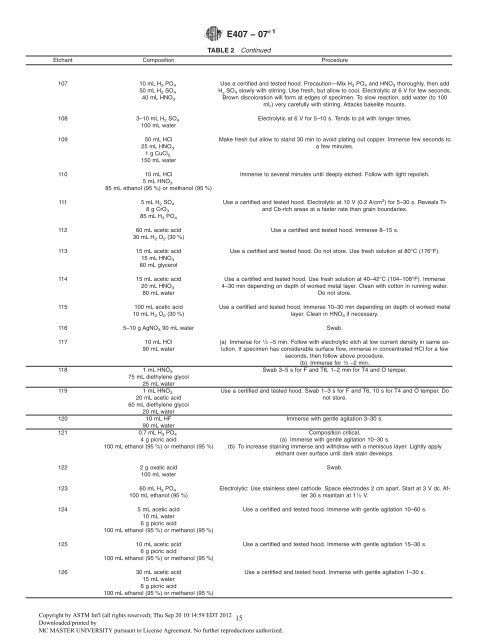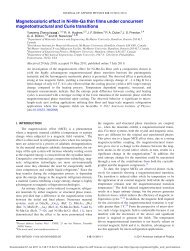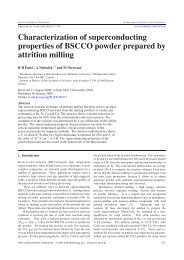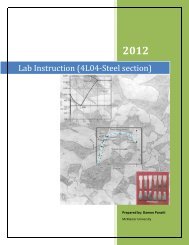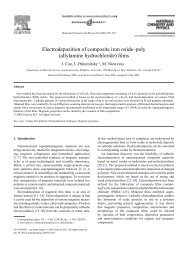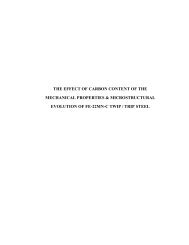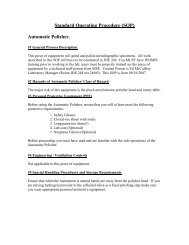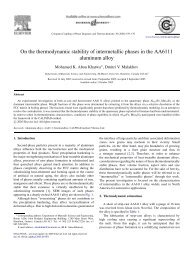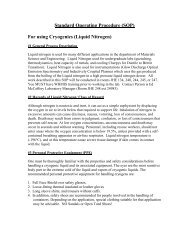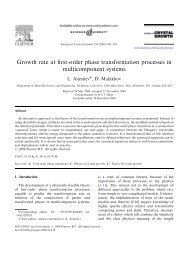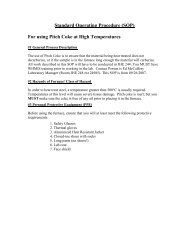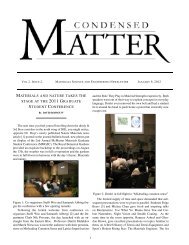E407-07 Microetching Metals and Alloys.pdf - McMaster Department ...
E407-07 Microetching Metals and Alloys.pdf - McMaster Department ...
E407-07 Microetching Metals and Alloys.pdf - McMaster Department ...
You also want an ePaper? Increase the reach of your titles
YUMPU automatically turns print PDFs into web optimized ePapers that Google loves.
TABLE 2 Continued<br />
Etchant Composition Procedure<br />
1<strong>07</strong> 10 mL H 3 PO 4<br />
50 mL H 2 SO 4<br />
40 mL HNO 3<br />
108 3–10 mL H 2 SO 4<br />
100 mL water<br />
109 50 mL HCl<br />
25 mL HNO 3<br />
1 g CuCl 2<br />
150 mL water<br />
110 10 mL HCl<br />
5 mL HNO 3<br />
85 mL ethanol (95 %) or methanol (95 %)<br />
111 5 mL H 2 SO 4<br />
8gCrO 3<br />
85 mL H 3 PO 4<br />
112 60 mL acetic acid<br />
30 mL H 2 O 2 (30 %)<br />
113 15 mL acetic acid<br />
15 mL HNO 3<br />
60 mL glycerol<br />
114 15 mL acetic acid<br />
20 mL HNO 3<br />
80 mL water<br />
115 100 mL acetic acid<br />
10 mL H 2 O 2 (30 %)<br />
Use a certified <strong>and</strong> tested hood. Precaution—Mix H 3 PO 4 <strong>and</strong> HNO 3 thoroughly, then add<br />
H 2 SO 4 slowly with stirring. Use fresh, but allow to cool. Electrolytic at 6Vforfewseconds.<br />
Brown discoloration will form at edges of specimen. To slow reaction, add water (to 100<br />
mL) very carefully with stirring. Attacks bakelite mounts.<br />
Electrolytic at 6 V for 5–10 s. Tends to pit with longer times.<br />
Make fresh but allow to st<strong>and</strong> 30 min to avoid plating out copper. Immerse few seconds to<br />
a few minutes.<br />
Immerse to several minutes until deeply etched. Follow with light repolish.<br />
Use a certified <strong>and</strong> tested hood. Electrolytic at 10 V (0.2 A/cm 2 ) for 5–30 s. Reveals Ti<strong>and</strong><br />
Cb-rich areas at a faster rate than grain boundaries.<br />
Use a certified <strong>and</strong> tested hood. Immerse 8–15 s.<br />
Use a certified <strong>and</strong> tested hood. Do not store. Use fresh solution at 80°C (176°F).<br />
Use a certified <strong>and</strong> tested hood. Use fresh solution at 40–42°C (104–108°F). Immerse<br />
4–30 min depending on depth of worked metal layer. Clean with cotton in running water.<br />
Do not store.<br />
Use a certified <strong>and</strong> tested hood. Immerse 10–30 min depending on depth of worked metal<br />
layer. Clean in HNO 3 if necessary.<br />
116 5–10 g AgNO 3 90 mL water Swab.<br />
117 10 mL HCl<br />
90 mL water<br />
118 1 mL HNO3 75 mL diethylene glycol<br />
25 mL water<br />
119 1 mL HNO3 20 mL acetic acid<br />
60 mL diethylene glycol<br />
20 mL water<br />
120 10 mL HF<br />
90 mL water<br />
121 0.7 mL H3 PO4 4 g picric acid<br />
100 mL ethanol (95 %) or methanol (95 %)<br />
122 2 g oxalic acid<br />
100 mL water<br />
123 60 mL H 3 PO 4<br />
100 mL ethanol (95 %)<br />
124 5 mL acetic acid<br />
10 mL water<br />
6 g picric acid<br />
100 mL ethanol (95 %) or methanol (95 %)<br />
125 10 mL acetic acid<br />
6 g picric acid<br />
100 mL ethanol (95 %) or methanol (95 %)<br />
126 30 mL acetic acid<br />
15 mL water<br />
6 g picric acid<br />
100 mL ethanol (95 %) or methanol (95 %)<br />
<strong>E4<strong>07</strong></strong> − <strong>07</strong> ´1<br />
Copyright by ASTM Int'l (all rights reserved); Thu Sep 20 10:14:59 EDT 2012<br />
15<br />
Downloaded/printed by<br />
MC MASTER UNIVERSITY pursuant to License Agreement. No further reproductions authorized.<br />
(a) Immerse for 1 ⁄2 –5 min. Follow with electrolytic etch at low current density in same solution.<br />
If specimen has considerable surface flow, immerse in concentrated HCl for a few<br />
seconds, then follow above procedure.<br />
(b) Immerse for 1 ⁄2 –2 min.<br />
Swab 3–5 s for F <strong>and</strong> T6, 1–2 min for T4 <strong>and</strong> O temper.<br />
Use a certified <strong>and</strong> tested hood. Swab 1–3 s for F <strong>and</strong> T6, 10 s for T4 <strong>and</strong> O temper. Do<br />
not store.<br />
Immerse with gentle agitation 3–30 s.<br />
Composition critical.<br />
(a) Immerse with gentle agitation 10–30 s.<br />
(b) To increase staining immerse <strong>and</strong> withdraw with a meniscus layer. Lightly apply<br />
etchant over surface until dark stain develops.<br />
Swab.<br />
Electrolytic: Use stainless steel cathode. Space electrodes 2 cm apart. Start at 3 V dc. After<br />
30 s maintain at 1 1 ⁄2 V.<br />
Use a certified <strong>and</strong> tested hood. Immerse with gentle agitation 10–60 s.<br />
Use a certified <strong>and</strong> tested hood. Immerse with gentle agitation 15–30 s.<br />
Use a certified <strong>and</strong> tested hood. Immerse with gentle agitation 1–30 s.


